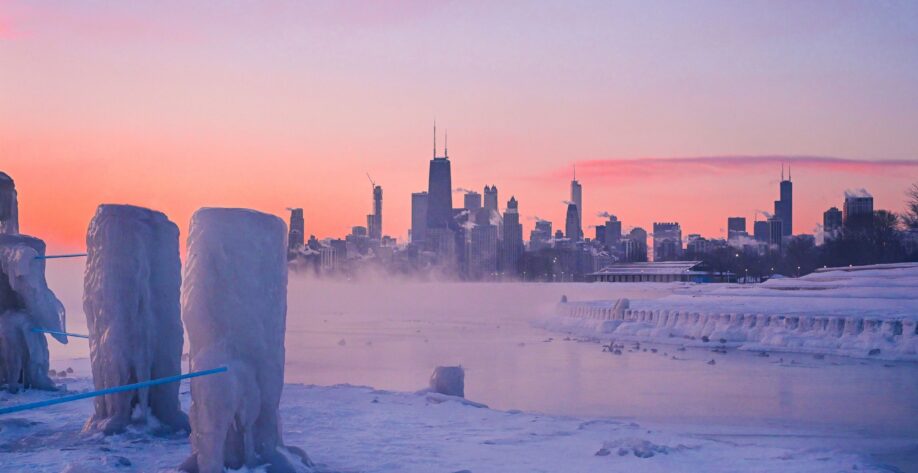What is the Polar Vortex?
While it sounds a bit like a phenomenon from a science fiction movie (remember the 2004 film The Day after Tomorrow?), the term polar vortex has been around for over one hundred years.
The following is a quick summary, but we’ll leave the technical weather talk to the meteorologists (you can dig deeper on your own by following the links below): One polar vortex exists at the north pole, and one at the south pole. They are effectively very large cyclones spinning high above the polar caps which have little effect on our daily lives.
When a polar vortex is strong, frigid arctic air stays fairly well-confined above each pole. But wait, what weakens the polar vortex and why is it suddenly about to split?
A sudden stratospheric warming event, which is an abrupt increase of temperature in the stratosphere above the polar cap, disrupts the vortex. Reports show that this event has already occurred and in the case of the northern polar vortex, this disruption causes arctic air to spin off the polar vortex towards the south.
Meteorologists are speculating that the polar vortex split this winter may bring weeks of cold weather and winter snowstorms to the northern part of the United States.
The Polar Vortex and Your Building:
What does this vortex have to do with your building? Well, as if the entire year of 2020 didn’t bring enough uncertainty to our lives, the effect that the 2021 sudden stratospheric warming event will have on the northern polar vortex is also unknown.
However, if the polar vortex split brings an extended period of very cold weather and snowstorms to our region, we need to be prepared. Large snowstorms, and even several consecutive snowstorms without above-freezing temperature that would bring relief by melting snow, can result in significant snow accumulation. (Remember the winter of 2015?)
Buildings are typically designed to support snow loads recommended by the applicable building code. This is determined by considering the contribution of roof slope, exposure factors, building use, and potential for snow drifts against parapets, adjacent rising walls, or buildings.
During extreme events such as severe snowfall, the actual snow load may exceed the load the roof was designed for. When snowfall is followed by rain or a short burst of warm weather and melting, the snow can absorb and retain water or thawed snow.
The slush layer trapped under the snow, which is normally not visible from above, can contribute to a much heavier load on the roof than it was designed for. If the actual roof loads exceed the design loads, the roof framing may be at risk for excessive deflections and, in the worst cases, localized failure or collapse.
What Can You Do to Prepare your Building for the Splitting Polar Vortex?
Let’s review a few important ways that you can plan ahead for the potential harsh winter weather which may be headed our way.
- Locate structural drawings of your existing building, including the roof plans and general notes sheets which typically list the design snow loads for the building. This information will be important if/when you need to engage a structural engineer to evaluate the snow loads on your roof. If structural drawings are not available, have pertinent information on hand such as the year your building was constructed and the roof framing member and deck types.
- Locate the existing architectural drawings or the latest re-roofing drawings. Before the snow starts to fall, familiarize yourself with the type and age of the roof system/covering and the locations of existing roof drains. Taking care not to damage the roof covering, consider installing temporary flags at each drain strainer, which extend above the anticipated snow layer for quick identification on a snow-covered roof. After a snow and/or rain event resulting in snow accumulation, you may want to remove snow from around the roof drains to provide a drainage path for melting snow. Personnel removing snow on and around roofs must be trained to take necessary safety precautions and use snow removal equipment intended to reduce the likelihood of damage to the roof system. The use of snow blowers and similar equipment is typically not recommended.
- If the snowfall forecast is significant for your area, contact your structural engineer to see if they can help you determine when you should proactively remove snow and in what areas of your roof. Many storms result in snow accumulation which falls within an acceptable range for the roof structure to support, and professional assistance may not be required.
What if You are Unsure if Snow Should be Removed from Your Building’s Roof?
Your roof may require localized snow removal at drains and snow drifts for one storm, and different snow removal after a subsequent storm.
Unfortunately, the height of the snow isn’t the only parameter required to measure the actual in-place snow load. Snow density and other factors will impact the recommended height of snow to remain on a roof.
If there is a question regarding the in-place snow or snow/rain load on your roof, Gale has the engineers, equipment, and experience to field-measure the snow and provide opinions and options regarding snow removal.
Please reach out to us anytime, whether you are preparing for the splitting of the polar vortex, reacting to subsequent snowstorms and frigid weather, or for any of your building envelope, structural engineering, or civil engineering needs.
Additional Information:
Popular Science: The polar vortex is about to split in two. But what does that actually mean?
CBS News: Sudden stratospheric warming could mean wild winter storms ahead

